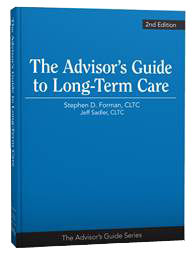
Long Term Care Insurance: The State of our Union is Strong
I recently had the pleasure of speaking in support of the Society of Actuaries’ Long Term Care Insurance (“LTCI”) Pricing Study, whose primary aim is to address the rate stability of new business within the context of three historical time periods: 2000, 2007 and present-day (2014). My colleagues Jim Glickman, FSA MAAA and Roger Loomis FSA MAAA spoke to the study itself and its underpinning data while my role was to add color by providing market perspective during the same time frame under scrutiny.
Since I have been claiming for the last few years that long term care is in a veritable Golden Age, it’s been a treat sharing the gospel of the LTCI Pricing Study. As more and more are learning for themselves, there has never been a better time to recommend LTCI, nor when consumers should feel so confident in the rates. But we’re getting ahead of ourselves…
THE MARKET
One of the most persistent trends we have seen over the last decade-and-a-half has been the upwardly mobile demographic of the LTCI market: higher incomes, higher net worth, increasing college education and fuller employment (which aligns with the downward trend in average purchase age). Ironically, this comes at a time when carriers have relentlessly tried to downshift into the “Middle Massmarket”.
Is it push or pull? Some would argue only the elite can afford our product anymore. But it might just as likely be we are catering to this niche. Ten years ago, specialists like LTCA would make a sale, after which our new client would run it past her Financial Advisor—only to see it quashed. Now, any Advisor worth his salt recommends LTCI as part of a balanced diet. In a remarkable turnaround, Financial Planners have become referral partners and centers of influence to the LTCI Specialist. But the ever-expanding Financial Advisor channel is enamored with assets under management, and chases the more profitable high net worth client. For their part, carriers have zealously worked to win over Advisors with attractively simple product designs, even as the latter have shown little appetite for Middle America.
We have also witnessed the rise of the so-called “Sandwich Generation.” As recently as the turn of the century, our applicants were in their 70’s—the tail end of the Greatest Generation. Now that we are catering to the leading edge of the Boomers, these clients in their 50’s are “sandwiched” between caring for parents and supporting children. On the one hand, they appreciate the pressing need of caregiving, while on the other they are pinched financially.
THE HEAD AND THE HEART
What motivates our policyholders to act? Although as marketers we have a tendency to cite emotional triggers (e.g. not being a burden on one’s family, or maintaining one’s independence), when we read the surveys, the #1 answer for the past 15-years always remains “asset protection.” In other words, for buyers LTCI is chiefly a financial product. This aligns with what we know of them: they are planners. They buy other financial protection products like life insurance, and make out their wills, advance directives and powers-of-attorney—all actions which show a concern for the future and for their loved ones.
What is fascinating about buyers are what they place emphasis on during their decision-making. Or rather, what they do not: cost and benefits. In other words, once they have committed they are comfortable accepting expert recommendations (which makes sense, when you imagine yourself in their shoes). As a rule of thumb, if something is truly important to you, money is no object, and no price is too high (within reason, of course). We will see how this is diametrically opposed to non-buyers: for them, no price is too low.
Historically, when we ask non-buyers what is holding them back the runaway answer is, “Price.” They do not see the value for what they are asked to spend. To put this in concrete terms, non-buyers are willing to pay an average annual premium of $1,128, an amount which is roughly ½ as much as real buyers are actually paying. They are either out of touch with what the product costs, or the industry is not meeting them where they are. Nevertheless, 50% say they are “on the fence,” meaning they have not permanently written off LTCI, and there are actions we can take to persuade them. Whatever we can do to either lower the cost of insurance (or lower their out-of-pocket costs for care) has the potential to win over non-buyers (e.g. rate guarantees, subsidies, co-insurance, or tax incentives). Importantly, the findings of the LTCI Pricing Study have the potential to alleviate the fears and mistrust surrounding rates.
APPEALING TO AGENTS
At the same time, where have the agents been? They have aged out, retired, or fled to higher ground (good agencies have left LTCI to pursue Medicare supplement sales and annuities where underwriting is easier and turnaround quicker). There were perhaps 40,000 agents seriously selling LTCI less than a decade ago, just 10,000 a couple years ago, and fewer than 500 estimated in attendance at this year’s LTC Solutions Summit. In all fairness, we have never had many true “Specialists”: 85% of financial professionals do not sell any LTCI, while just 2% are considered serious adopters. (One carrier reports that 90% of its 100,000 producers submit just 1 – 5 applications per year; and of those, ½ submit only one.)
The graying of the workforce is well-established: our average client is 59 while the average agent is 59, too. The founder of the CLTC professional designation recently sold his business at the age of 67, explicitly citing business succession as a concern. With agent retirements looming, business succession was featured at last year’s ILTCI Conference, and renewal commission purchases at this year’s LTC Solutions Summit. Not coincidentally, as online sales have supplanted the kitchen table, an entire generation of experienced veterans who’ve not cared to make the digital transition (or been unable) has created a seminal moment in LTCI as surely as “talkies” changed silent films.
When we ask agents to name their concerns, they share many with our customers: the cost of the product, rate increases, and carrier exits. This once again points to the Pricing Study: professionals know they ought to recommend LTCI but need to be reassured it is safe to do so. To paraphrase Mr. Glickman, “agents placed too much faith in the market when it may not have earned it; and now have too little faith in the industry when it does deserve it.”
Distribution is much attuned to the product developments made by the carriers. Among the most noticeable have been “de-risking”, perceived by agents as making the product more difficult to sell. De-risking includes pulling lifetime benefits, withdrawing indemnity payments, capping monthly maximums, restricting informal caregiving, and moving to gender-distinct rates. Underwriting can also de-risk, of course, from lowering the maximum age, imposing life-type underwriting on LTCI (e.g. blood labs and urinalysis), and minimizing the role of the agent through the use of “ticket” style applications (shifting health-gathering and verification either in-house or to a licensed healthcare practitioner).
This last move has an added appeal: the Holy Grail of most insurers is creating an LTCI program that is saleable by its life and annuity distributors. Since this is typically a carrier’s largest number of agents, putting a simplified product and process in their hands can theoretically amplify sales. To do so, carriers have tried many times to create “vanilla” versions of their rack products, usually with tepid results. Vanilla-ization leads to spreadsheeting, and spreadsheeting is a race to the bottom.
A WIDER TENT
Over the past dozen years one cannot ignore the ascension of combination products (aka linked-benefit, hybrid or asset-based). For a time these were pitted against LTCI, and sold on its grave (“You should buy hybrid products because LTCI is dead, because it is a use-it-or-lose-it proposition, because it is subject to steep and unpredictable rate increases,”) but such animosity has started to ebb now that agents appreciate one sale does not cannibalize the other, but rather supplements it. These are clients we had already lost, who were on the verge of walking away. They said, “I don’t want what you’ve got, I’m going to self-insure.” Now we can say, “We’ve got an answer for you: a better way to self-insure.”
This wider tent is one of our industry’s great untold success stories. What was once an “LTC insurance” conversation is now one of “LTC solutions.” While traditional LTCI sales have decreased, by the time we add back in the offsetting sales from combination products and short-term care (“STC”), the picture brightens considerably.
Much ink has already been spilled over carrier exits. Although the topic creates an outsize reaction in the media (what we call a “negative headwind”), carrier exits are sound and fury signifying nothing: sales have always been concentrated among a few market leaders. What happens among the niche carriers is irrelevant, so their absence is barely noticed. In fact, our firm represents more LTCI carriers today than we did back when there were 116. What is the proper number? I don’t know, but the market will decide, since the right number of buyers will only support the right number of carriers, an outcome I call “economic evolution”.
Perhaps the only absence we have not recovered from has been the disappearance of a national “impaired-risk” carrier that has never been replaced (as polarizing as the company was). The industry underestimated its role, now fulfilled by a patchwork of regional players. This carrier gobbled up a great deal of substandard business—business that is now being submitted to A-rated carriers and hounding their placement rates. Likewise, when our industry disenfranchises ¼ of the people who wish to purchase our product, we open the door to public scrutiny and programs like the CLASS Act (or the next variant to come down the pike).
TAKING BACK THE NARRATIVE
Carrier exits have thinned the herd and left us with a committed group. But those I call the Jupiter-class gas giants must regrettably live with “overhang” in the form of large blocks of beleaguered business. Of these inforce blocks a colleague quipped, “It’s like dragging a refrigerator through the sand.” More great news from the Pricing Study: what a fortuitous time for a new, unencumbered carrier to make a fresh start selling LTCI! With cutting-edge assumptions, the benefit of others’ experience, and no overhang, a daring carrier might be rewarded with a terrific amount of upside.
We have not done a great job framing our own narrative over the past two decades, instead letting the story be chosen for us. Ironically, it used to be that “long-term care” was perceived by the public as the risk (rightfully so). Today, in story after story written by the financially illiterate “long-term care insurance” is pitched as the risk (because you might not get to “use it”, or because it is not a good “investment”). Has the world gone mad?
Certainly, some are disenchanted by a product that is more expensive and harder to qualify for than they remember. But let us put such nostalgia in perspective. I liken it to our fascination with a 50-mpg car, forgetting that the Honda CRX hit this goal in 1987. But it only did so thanks to a lack of consumer protections we take for granted today, such as anti-lock brakes, airbags, and collision avoidance systems. Each safety measure (let alone each modern convenience like power steering, cruise control and GPS navigation) adds incrementally to the price of a car.
Same with LTCI, whose cheaper policies were incredibly threadbare by today’s standards. Every consumer protection comes with a price, and adds to the cost of the base product. While it is harder to get good gas mileage when you are weighed-down, today’s policies are also incredibly safe in the event of a crash. The blame is on us for not doing a better job promoting such consumer protections as 3rd-party claims review, timely payment of claims, 3rd-party lapse designation, contingent nonforfeiture, moderately adverse experience (MAE) pricing, pre-existing condition limitations, and contestability restrictions.
The LTCI Pricing Study has been on a whistle-stop tour for several months now, and the response from agents is always enthusiastic. Not only do they find the information reinvigorating, but they always ask how we can catapult the message to consumers. On an almost daily basis, I encounter misinformation online, which is why it is so important to take these opportunities to bring agents and consumers back to the fold. I know they will come away convinced there has never been a better time than now to sell—or buy—long-term care insurance.





